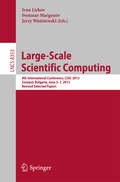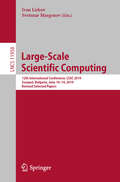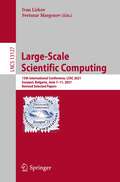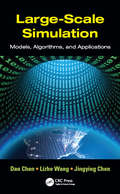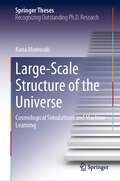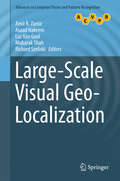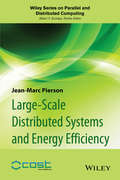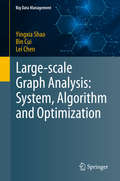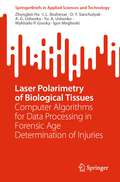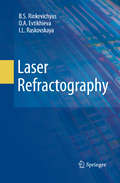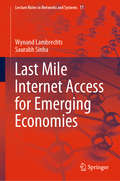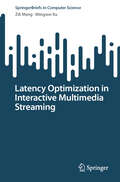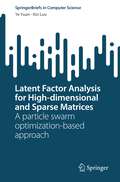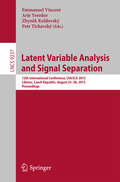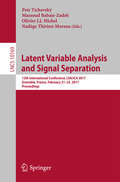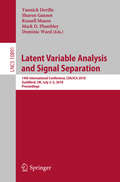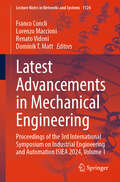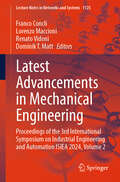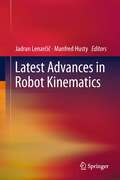- Table View
- List View
Large-Scale Scientific Computing
by Ivan Lirkov Svetozar Margenov Jerzy WaśniewskiThis book constitutes the thoroughly refereed post-conference proceedings of the 9th International Conference on Large-Scale Scientific Computations, LSSC 2013, held in Sozopol, Bulgaria, in June 2013. The 74 revised full papers presented together with 5 plenary and invited papers were carefully reviewed and selected from numerous submissions. The papers are organized in topical sections on numerical modeling of fluids and structures; control and uncertain systems; Monte Carlo methods: theory, applications and distributed computing; theoretical and algorithmic advances in transport problems; applications of metaheuristics to large-scale problems; modeling and numerical simulation of processes in highly heterogeneous media; large-scale models: numerical methods, parallel computations and applications; numerical solvers on many-core systems; cloud and grid computing for resource-intensive scientific applications.
Large-Scale Scientific Computing
by Ivan Lirkov Svetozar MargenovThepapersinthis volumewerepresentedatthe4thInternationalConferenceon Large-Scale Scienti'c Computations ICLSSC 2003. It was held in Sozopol, B- garia, June 4-8, 2003. The conference was organized and sponsored by the C- tral Laboratory for Parallel Processing at the Bulgarian Academy of Sciences. Support was also provided from the Center of Excellence "BIS 21" (funded by the European Commission), SIAM and GAMM. A co-organizer of this tra- tional scienti'c meeting was the Division of Numerical Analysis and Statistics of the University of Rousse. The success of the conference and the present volume in particular are the outcome of the joint e'orts of many colleagues from various institutions and organizations. First thanks to all the members of the Scienti'c Committee for their valuable contribution to forming the scienti'c face of the conference, as well as for their help in reviewing contributed papers. We would like to specially thank the organizers of the special sessions: R. Blaheta, N. Dimitrova, A. Ebel, K. Georgiev, O. Iliev, A. Karaivanova, H. Kosina, M. Krastanov, U. Langer, P. Minev, M. Neytcheva, M. Sch] afer, V. Veliov, and Z. Zlatev. We are also grateful to the sta? involved in the local organization. Special Events: - The conference was devoted to the 60th anniversary of Raytcho Lazarov. - During the conference, the nomination for the World Level of the Hall of Fame for Engineering, Science and Technology, HOFEST, was o'cially awarded to Owe Axelsson.
Large-Scale Scientific Computing: 12th International Conference, LSSC 2019, Sozopol, Bulgaria, June 10–14, 2019, Revised Selected Papers (Lecture Notes in Computer Science #11958)
by Ivan Lirkov Svetozar MargenovThis book constitutes revised papers from the 12th International Conference on Large-Scale Scientific Computing, LSSC 2019, held in Sozopol, Bulgaria, in June 2019. The 70 papers presented in this volume were carefully reviewed and selected from 81 submissions. The book also contains two invited talks. The papers were organized in topical sections named as follows: control and optimization of dynamical systems; meshfree and particle methods; fractional diffusion problems: numerical methods, algorithms and applications; pore scale flow and transport simulation; tensors based algorithms and structures in optimization and applications; HPC and big data: algorithms and applications; large-scale models: numerical methods, parallel computations and applications; monte carlo algorithms: innovative applications in conjunctions with other methods; application of metaheuristics to large-scale problems; large scale machine learning: multiscale algorithms and performance guarantees; and contributed papers.
Large-Scale Scientific Computing: 13th International Conference, LSSC 2021, Sozopol, Bulgaria, June 7–11, 2021, Revised Selected Papers (Lecture Notes in Computer Science #13127)
by Ivan Lirkov Svetozar MargenovThis book constitutes revised selected papers from the 13th International Conference on Large-Scale Scientific Computing, LSSC 23021, which was held in Sozopol, Bulgaria, during June 7-11, 2021. The 60 papers included in this book were carefully reviewed and selected from a total of 73 submissions. The volume also includes two invited talks in full paper length. The papers were organized in topical sections as follows: Fractional diffusion problems: numerical methods, algorithms and applications; large-scale models: numerical methods, parallel computations and applications; application of metaheuristics to large-scale problems; advanced discretizations and solvers for coupled systems of partial differential equations; optimal control of ODEs, PDEs and applications; tensor and matrix factorization for big-data analysis; machine learning and model order reduction for large scale predictive simulations; HPC and big data: algorithms and applications; and contributed papers.
Large-Scale Simulation: Models, Algorithms, and Applications
by Lizhe Wang Dan Chen Jingying ChenLarge-Scale Simulation: Models, Algorithms, and Applications gives you firsthand insight on the latest advances in large-scale simulation techniques. Most of the research results are drawn from the authors’ papers in top-tier, peer-reviewed, scientific conference proceedings and journals. The first part of the book presents the fundamentals of large-scale simulation, including high-level architecture and runtime infrastructure. The second part covers middleware and software architecture for large-scale simulations, such as decoupled federate architecture, fault tolerant mechanisms, grid-enabled simulation, and federation communities. In the third part, the authors explore mechanisms—such as simulation cloning methods and algorithms—that support quick evaluation of alternative scenarios. The final part describes how distributed computing technologies and many-core architecture are used to study social phenomena. Reflecting the latest research in the field, this book guides you in using and further researching advanced models and algorithms for large-scale distributed simulation. These simulation tools will help you gain insight into large-scale systems across many disciplines.
Large-Scale Structure of the Universe: Cosmological Simulations and Machine Learning (Springer Theses)
by Kana MoriwakiLine intensity mapping (LIM) is an observational technique that probes the large-scale structure of the Universe by collecting light from a wide field of the sky. This book demonstrates a novel analysis method for LIM using machine learning (ML) technologies. The author develops a conditional generative adversarial network that separates designated emission signals from sources at different epochs. It thus provides, for the first time, an efficient way to extract signals from LIM data with foreground noise. The method is complementary to conventional statistical methods such as cross-correlation analysis. When applied to three-dimensional LIM data with wavelength information, high reproducibility is achieved under realistic conditions. The book further investigates how the trained machine extracts the signals, and discusses the limitation of the ML methods. Lastly an application of the LIM data to a study of cosmic reionization is presented. This book benefits students and researchers who are interested in using machine learning to multi-dimensional data not only in astronomy but also in general applications.
Large-Scale Visual Geo-Localization
by Mubarak Shah Amir R. Zamir Asaad Hakeem Luc Van Gool Richard SzeliskiThistimely and authoritative volume explores the bidirectional relationship betweenimages and locations. The text presents a comprehensive review of the state ofthe art in large-scale visual geo-localization, and discusses the emergingtrends in this area. Valuable insights are supplied by a pre-eminent selectionof experts in the field, into a varied range of real-world applications ofgeo-localization. Topics and features: discusses the latest methods to exploitinternet-scale image databases for devising geographically rich features andgeo-localizing query images at different scales; investigates geo-localizationtechniques that are built upon high-level and semantic cues; describes methodsthat perform precise localization by geometrically aligning the query imageagainst a 3D model; reviews techniques that accomplish image understandingassisted by the geo-location, as well as several approaches for geo-localizationunder practical, real-world settings.
Large-scale Distributed Systems and Energy Efficiency
by Jean-Marc PiersonAddresses innovations in technology relating to the energy efficiency of a wide variety of contemporary computer systems and networks With concerns about global energy consumption at an all-time high, improving computer networks energy efficiency is becoming an increasingly important topic. Large-Scale Distributed Systems and Energy Efficiency: A Holistic View addresses innovations in technology relating to the energy efficiency of a wide variety of contemporary computer systems and networks. After an introductory overview of the energy demands of current Information and Communications Technology (ICT), individual chapters offer in-depth analyses of such topics as cloud computing, green networking (both wired and wireless), mobile computing, power modeling, the rise of green data centers and high-performance computing, resource allocation, and energy efficiency in peer-to-peer (P2P) computing networks. Discusses measurement and modeling of the energy consumption method Includes methods for energy consumption reduction in diverse computing environments Features a variety of case studies and examples of energy reduction and assessment Timely and important, Large-Scale Distributed Systems and Energy Efficiency is an invaluable resource for ways of increasing the energy efficiency of computing systems and networks while simultaneously reducing the carbon footprint.
Large-scale Graph Analysis: System, Algorithm and Optimization (Big Data Management)
by Bin Cui Lei Chen Yingxia ShaoThis book introduces readers to a workload-aware methodology for large-scale graph algorithm optimization in graph-computing systems, and proposes several optimization techniques that can enable these systems to handle advanced graph algorithms efficiently. More concretely, it proposes a workload-aware cost model to guide the development of high-performance algorithms. On the basis of the cost model, the book subsequently presents a system-level optimization resulting in a partition-aware graph-computing engine, PAGE. In addition, it presents three efficient and scalable advanced graph algorithms – the subgraph enumeration, cohesive subgraph detection, and graph extraction algorithms. This book offers a valuable reference guide for junior researchers, covering the latest advances in large-scale graph analysis; and for senior researchers, sharing state-of-the-art solutions based on advanced graph algorithms. In addition, all readers will find a workload-aware methodology for designing efficient large-scale graph algorithms.
Las fantásticas luciérnagas
by Oscar S. ArandaOscar S. Aranda desvela los secretos que se esconden tras la luz de las luciérnagas. A través de los recuerdos, el autor de El lenguaje secreto de la naturaleza nos invita a descubrir el luminoso sistema de comunicación de las luciérnagas. Unos insectos que frecuentemente se han comparado con las hadas y que se han visto obligados a adaptarse de formas sorprendentes a la contaminación lumínica actual.
Laser Additive Manufacturing of High-Performance Materials
by Dongdong GuThis book entitled "Laser Additive Manufacturing of High-Performance Materials" covers the specific aspects of laser additive manufacturing of high-performance new materials components based on an unconventional materials incremental manufacturing philosophy, in terms of materials design and preparation, process control and optimization and theories of physical and chemical metallurgy. This book describes the capabilities and characteristics of the development of new metallic materials components by laser additive manufacturing process, including nanostructured materials, in situ composite materials, particle reinforced metal matrix composites, etc. The topics presented in this book, similar as laser additive manufacturing technology itself, show a significant interdisciplinary feature, integrating laser technology, materials science, metallurgical engineering and mechanical engineering. This is a book for researchers, students, practicing engineers and manufacturing industry professionals interested in laser additive manufacturing and laser materials processing. Dongdong Gu is a Professor at College of Materials Science and Technology, Nanjing University of Aeronautics and Astronautics (NUAA), PR China.
Laser Polarimetry of Biological Tissues: Computer Algorithms for Data Processing in Forensic Age Determination of Injuries (SpringerBriefs in Applied Sciences and Technology)
by A. G. Ushenko Yu. A. Ushenko Igor Meglinski Zhengbin Hu I.L. Bezhenar O.Y. Vanchulyak Mykhailo P. GorskyThis book highlights the results of numerical computer-aided smart methods as part of a comprehensive statistical, correlated, and fractal analysis of laser polarimetry. It includes a comprehensive approach to differentiation of lifelong or postmortem origin of injuries and determination of their antiquity based on the analysis of statistical and spatiotemporal frequency evolution of photometric, polarization, and phase parameters of laser images of histological sections of the skin of biomannequins. It discusses the relationship between the coordinate distributions of the intensity of laser images from skin tissues of biomannequins and the nature of its damage. It presents the analysis of relationships between changes in the mean and variance of coordinate distributions of azimuths and ellipticity of polarization images of histological skin sections and the time intervals after injury. Complex differentiation of lifelong and postmortem skin injuries of biomannequins and establishment of their time intervals throughout the entire monitoring interval of changes in the mean and variance of coordinate distributions of phase shifts between orthogonal components of the amplitude of laser images of a series of corresponding histological sections are also presented in this book.
Laser Refractography
by I. L. Raskovskaya B. S. Rinkevichyus O. A. EvtikhievaThis book describes the basic principles of laser refractography, a flexible new diagnostic tool for measuring optically inhomogeneous media and flows. Laser refractography is based on digital imaging and computer processing of structured laser beam refraction (SLR) in inhomogeneous transparent media. Laser refractograms provide both qualitative and quantitative measurements and can be used for the study of fast and transient processes. In this book, the theoretical basis of refractography is explored in some detail, and experimental setups are described for measurement of transparent media using either 2D (passed radiation) or 3D (scattered radiation) refractograms. Specific examples and applications are discussed, including visualization of the boundary layer near a hot or cold metallic ball in water, and observation of edge effects and micro layers in liquids and gases. As the first book to describe this new and exciting technique, this monograph has broad cross-disciplinary appeal and will be of interest to students and researchers who need to characterize complex fluid behavior.
Last Mile Internet Access for Emerging Economies (Lecture Notes in Networks and Systems #77)
by Saurabh Sinha Wynand LambrechtsThis book presents an investigative approach to globalization-driving technologies that efficiently deliver ubiquitous, last-mile, broadband internet access to emerging markets and rural areas. Research has shown that ubiquitous internet access boosts socio-economic growth through innovations in science and technology, and has a positive effect on the lives of individuals. Last-mile internet access in developing countries is not only intended to provide areas with stable, efficient, and cost-effective broadband capabilities, but also to encourage the use of connectivity for human capacity development. The book offers an overview of the principles of various technologies, such as light fidelity and millimeter-wave backhaul, as last-mile internet solutions and describes these potential solutions from a signal propagation perspective. It also provides readers with the notional context needed to understand their operation, benefits, and limitations, and enables them to investigate feasible and tailored solutions to ensure sustainable infrastructures that are expandable and maintainable.
Late-Night in Washington: Political Humor and the American Presidency
by S. Robert Lichter Stephen J. Farnsworth Farah LatifThis book traces the trajectory of late-night political humor, which has long been a staple of entertainment television and is now a prominent part of social media political discourse, especially when it comes to the presidency. From Richard Nixon on Laugh-In to Donald Trump’s avatar on Saturday Night Live, this book takes the next step and considers how late-night comedy treats Joe Biden, the new American president who strives to restore a civil public tone but offers far less comedy fodder than his predecessor. Employing content analysis, public opinion surveys, and a variety of other quantitative and qualitative research, the authors look beyond the day-to-day memes and mimes of late-night comics and show how political humor may evolve. For students and scholars of politics and the media, this book will appeal to the general public and political pundits as well.
Late-Night in Washington: Political Humor and the American Presidency
by S. Robert Lichter Stephen J. Farnsworth Farah LatifThis book traces the trajectory of late-night political humor, which has long been a staple of entertainment television and is now a prominent part of social media political discourse, especially when it comes to the presidency. From Richard Nixon on Laugh-In to Donald Trump’s avatar on Saturday Night Live, this book takes the next step and considers how late-night comedy treats Joe Biden, the new American president who strives to restore a civil public tone but offers far less comedy fodder than his predecessor. Employing content analysis, public opinion surveys, and a variety of other quantitative and qualitative research, the authors look beyond the day-to-day memes and mimes of late-night comics and show how political humor may evolve. For students and scholars of politics and the media, this book will appeal to the general public and political pundits as well.
Latency Optimization in Interactive Multimedia Streaming (SpringerBriefs in Computer Science)
by Mingwei Xu Zili MengWith the emergence of virtual reality and augmented reality, the era of interactive multimedia streaming looms on the horizon. Network latency emerges as a critical factor in the performance of interactive multimedia streaming applications. As the demand for interactive multimedia streaming continues to surge, comprehending and mitigating the challenges posed by network latency becomes increasingly imperative. This book begins by introducing the fundamentals of network latency, elucidating its sources from both data plane and control plane, along with its effects on user experience. Furthermore, it explores the various components contributing latency, including the application layer, transport layer, and network layer. The book then delves into the ongoing research efforts aimed at reducing the latency of these components individually. By the book's conclusion, readers will have gained a comprehensive understanding of network latency in interactive multimedia streaming, equipped with the knowledge and tools necessary to design and optimize low-latency streaming systems. Whether you are a network engineer, multimedia developer, or researcher, this book will furnish you with valuable insights and practical guidance to confront the challenges of network latency head-on.
Latent Factor Analysis for High-dimensional and Sparse Matrices: A particle swarm optimization-based approach (SpringerBriefs in Computer Science)
by Ye Yuan Xin LuoLatent factor analysis models are an effective type of machine learning model for addressing high-dimensional and sparse matrices, which are encountered in many big-data-related industrial applications. The performance of a latent factor analysis model relies heavily on appropriate hyper-parameters. However, most hyper-parameters are data-dependent, and using grid-search to tune these hyper-parameters is truly laborious and expensive in computational terms. Hence, how to achieve efficient hyper-parameter adaptation for latent factor analysis models has become a significant question.This is the first book to focus on how particle swarm optimization can be incorporated into latent factor analysis for efficient hyper-parameter adaptation, an approach that offers high scalability in real-world industrial applications. The book will help students, researchers and engineers fully understand the basic methodologies of hyper-parameter adaptation via particle swarm optimization in latent factor analysis models. Further, it will enable them to conduct extensive research and experiments on the real-world applications of the content discussed.
Latent Variable Analysis and Signal Separation
by Emmanuel Vincent Arie Yeredor Zbyněk Koldovský Petr TichavskýThis book constitutes the proceedings of the 12th International Conference on Latent Variable Analysis and Signal Separation, LVA/ICS 2015, held in Liberec, Czech Republic, in August 2015. The 61 revised full papers presented - 29 accepted as oral presentations and 32 accepted as poster presentations - were carefully reviewed and selected from numerous submissions. Five special topics are addressed: tensor-based methods for blind signal separation; deep neural networks for supervised speech separation/enhancement; joined analysis of multiple datasets, data fusion, and related topics; advances in nonlinear blind source separation; sparse and low rank modeling for acoustic signal processing.
Latent Variable Analysis and Signal Separation
by Petr Tichavský Massoud Babaie-Zadeh Olivier J.J. Michel Nadège Thirion-MoreauThis book constitutes the proceedings of the 13th International Conference on Latent Variable Analysis and Signal Separation, LVA/ICA 2017, held in Grenoble, France, in Feburary 2017. The 53 papers presented in this volume were carefully reviewed and selected from 60 submissions. They were organized in topical sections named: tensor approaches; from source positions to room properties: learning methods for audio scene geometry estimation; tensors and audio; audio signal processing; theoretical developments; physics and bio signal processing; latent variable analysis in observation sciences; ICA theory and applications; and sparsity-aware signal processing.
Latent Variable Analysis and Signal Separation: 14th International Conference, LVA/ICA 2018, Guildford, UK, July 2–5, 2018, Proceedings (Lecture Notes in Computer Science #10891)
by Mark D. Plumbley Sharon Gannot Yannick Deville Russell Mason Dominic WardThis book constitutes the proceedings of the 14th International Conference on Latent Variable Analysis and Signal Separation, LVA/ICA 2018, held in Guildford, UK, in July 2018.The 52 full papers were carefully reviewed and selected from 62 initial submissions. As research topics the papers encompass a wide range of general mixtures of latent variables models but also theories and tools drawn from a great variety of disciplines such as structured tensor decompositions and applications; matrix and tensor factorizations; ICA methods; nonlinear mixtures; audio data and methods; signal separation evaluation campaign; deep learning and data-driven methods; advances in phase retrieval and applications; sparsity-related methods; and biomedical data and methods.
Latest Advancements in Mechanical Engineering: Proceedings of the 3rd International Symposium on Industrial Engineering and Automation ISIEA 2024, Volume 1 (Lecture Notes in Networks and Systems #1124)
by Dominik T. Matt Renato Vidoni Franco Concli Lorenzo MaccioniThis book aims at bringing together academic and industry, researchers in mechanical engineering and their worldwide partners in a stimulating environment. ISIEA is an annual event that takes place in Bolzano and is organized by the Industrial Engineering and Automation macro-area of the Free University of Bozen/Bolzano. The main theme of the 2024 edition covers all major areas of R&D and innovation in advanced mechanical engineering. Special sessions on tribology and materials, modeling and simulations, powertrains, applied mechanics and robotics have been presented. Special track related to life and efficiency of bearings; cycloidal speed reducers; multi-physics modeling approaches; infrared thermography; planning and control of robotic and mechatronic systems; mobile field robotics; formulations and applications of structural and multibody dynamics; innovative solutions for safer and more sustainable mobility; artificial intelligence in manufacturing and mechanical engineering; advancements in aerospace technologies; innovative engineering education; SME 5.0: intelligent, sustainable and human-centered SMEs have been presented.
Latest Advancements in Mechanical Engineering: Proceedings of the 3rd International Symposium on Industrial Engineering and Automation ISIEA 2024, Volume 2 (Lecture Notes in Networks and Systems #1125)
by Dominik T. Matt Renato Vidoni Franco Concli Lorenzo MaccioniThis book aims at bringing together academic and industry, researchers in mechanical engineering and their worldwide partners in a stimulating environment. ISIEA is an annual event that takes place in Bolzano and is organized by the Industrial Engineering and Automation macro-area of the Free University of Bozen/Bolzano. The main theme of the 2024 edition covers all major areas of R&D and innovation in advanced mechanical engineering. Special sessions on tribology and materials, modeling and simulations, powertrains, applied mechanics and robotics have been presented. Special track related to life and efficiency of bearings; cycloidal speed reducers; multi-physics modeling approaches; infrared thermography; planning and control of robotic and mechatronic systems; mobile field robotics; formulations and applications of structural and multibody dynamics; innovative solutions for safer and more sustainable mobility; artificial intelligence in manufacturing and mechanical engineering; advancements in aerospace technologies; innovative engineering education; SME 5.0: intelligent, sustainable and human-centered SMEs have been presented.
Latest Advances in Robot Kinematics
by Jadran Lenarcic Manfred HustyThis book is of interest to researchers inquiring about modern topics and methods in the kinematics, control and design of robotic manipulators. It considers the full range of robotic systems, including serial, parallel and cable driven manipulators, both planar and spatial. The systems range from being less than fully mobile to kinematically redundant to overconstrained. In addition to recognized areas, this book also presents recent advances in emerging areas such as the design and control of humanoids and humanoid subsystems, and the analysis, modeling and simulation of human body motions, as well as the mobility analysis of protein molecules and the development of machines which incorporate man.
Lattice Coding for Signals and Networks
by Ram ZamirUnifying information theory and digital communication through the language of lattice codes, this book provides a detailed overview for students, researchers and industry practitioners. It covers classical work by leading researchers in the field of lattice codes and complementary work on dithered quantization and infinite constellations, and then introduces the more recent results on 'algebraic binning' for side-information problems, and linear/lattice codes for networks. It shows how high dimensional lattice codes can close the gap to the optimal information theoretic solution, including the characterisation of error exponents. The solutions presented are based on lattice codes, and are therefore close to practical implementations, with many advanced setups and techniques, such as shaping, entropy-coding, side-information and multi-terminal systems. Moreover, some of the network setups shown demonstrate how lattice codes are potentially more efficient than traditional random-coding solutions, for instance when generalising the framework to Gaussian networks.
